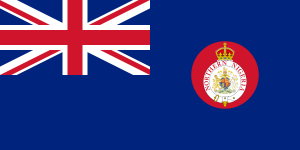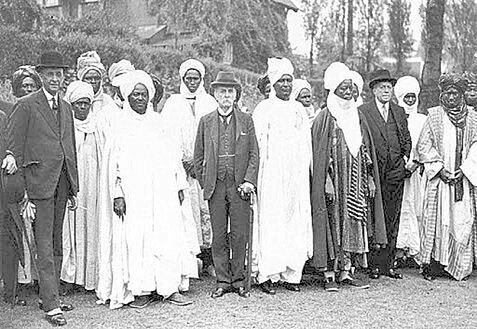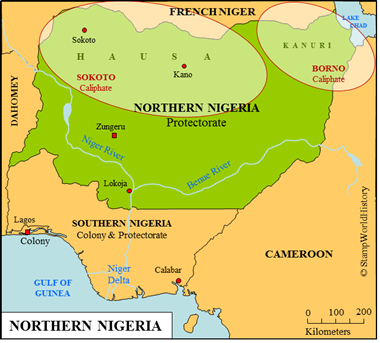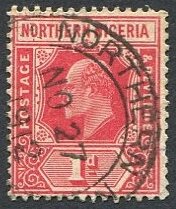
Northern Nigeria
Quick reference
General issues: British protectorate 1900-1914
Country name on general issues: Northern Nigeria
Currency: 1 Pound = 20 Shilling, 1 Shilling = 12 Pence 1900-1914
Population: 8 120 000 in 1911
Political history Northern Nigeria
Northern Nigeria is located in western Africa in the current Nigeria. The population is diverse. In the southern part many different Niger-Congo peoples live. In the northern part the population consists of Afro-Asiatic peoples – the largest population group being the Hausa. In the northeast Nilo-Saharan peoples live – the Kanuri being the largest group. Europeans had first explored the coast of Nigeria in the late 15th century. Trade posts were established in the 16th century. The Nigerian hinterland was not explored until the late 17th and early 18th centuries.
Events take a different course in the 19th century. In the mid 19th century the British have focused their attention on the lower Niger basin and initially establish themselves in the coastal regions. Private companies expand trade from the coastal regions into the hinterland. In the late 19th century, the ‘Scramble for Africa’ is at its height. At the 1885 Berlin conference – where the colonial powers divide their respective spheres of interest in Africa – Great Britain claims and is awarded the entire lower Niger basin[1]The current Nigeria, then called the Niger Districts. .
In 1886, large parts of the Niger Districts are contracted out for further development to the Royal Niger Company – a chartered company. Although the Company administers part of the Niger Delta, the main focus of the Company is to develop the hinterland. The Company sets up its headquarters in Lokoja and from there extends its activities up the Niger and Benue Rivers. Over time the Company proves not to be the right vehicle to establish effective British rule – establishing effective rule being a prerequisite of the 1885 Berlin conference for continued recognition of territorial claims. Although the Royal Niger Company negotiates treaties of protection with many of the local rulers, its focus is on trade and not on the administration of the acquired territories. Thus, in 1899, the charter of the Company is revoked. In 1900, the territories administered by the Royal Niger Company are transferred to the British Government. The Company will remain active in trade only.

1900 – Frederick Lugard with Hausa Emirs. Lugard played a key role in shaping colonial Nigeria. Lugard was High Commissioner of Northern Nigeria from 1900 until 1906, Governor of Northern and Southern Nigeria from 1912 until 1914 and Governor of Nigeria from 1914 until 1919.
The British government, after the transfer of the administration from the Royal Niger Company in 1900, forms the protectorate of Northern Nigeria. At the time of the transfer, only part of the protectorate is under British control. A campaign in 1902 brings the Kanuri caliphate of Borno – a downsized version of the Borno sultanate that in 1900 was defeated by the French in neighboring Chad – under British rule. A more formidable opponent is the Hausa caliphate of Sokoto. The Sokoto caliphate had been established in early 19th century as a ‘Jihad State’ – a state of which several came into existence in western Africa in the 18th and 19th centuries with the goal to expand and spread Islam. Centered in Sokoto the caliphate had rapidly expanded. By the end of the 19th century it controlled large parts of northern Nigeria beyond the city of Kano. The Sokoto caliphate is subdued in a 1903 campaign. Thus, most of Northern Nigeria has been brought under control of the British, although pockets of resistance existed and revolts occurred until 1907. The capital is moved, in 1902, from Lokoja to Zungeru. To administer Northern Nigeria, the British would establish indirect rule through the existing royalty.
In 1914, Northern Nigeria is joined with Southern Nigeria to form the colony and protectorate of Nigeria. Nigeria gains independence in 1960. The former Northern Nigeria is currently split up to form a number of states in modern day Nigeria.
Postal history Northern Nigeria
The first post office in the future Northern Nigeria is opened in 1899 by the Royal Niger Company in Lokoja. British stamps were used. The first stamps for Northern Nigeria are issued in 1900. These, and subsequent issues, are all of the designs common for British possessions. The last stamps are issued in 1912. Where the highest denomination is £ 1 for the regular issues, an exceptional stamp has been issued in 1904: a £ 25 face value stamp available for postal use – but probably only used fiscally, a stamp with a very high catalog value. The stamps of Northern Nigeria are, from 1914, superseded by the stamps of the Nigeria colony & protectorate and, from 1960, by the stamps of independent Nigeria.
Album pages
← Previous page: NigeriaNext page: Northern Rhodesia →




And the posts keep on coming!
Gerben- the only criticism I have- and it is hardly a criticism- is that you publish so rapidly that I do not have time to savor your posts.
Anyway, keep your posts- and your great maps- coming!
Jim, isn’t that just a matter of setting the right priorities? Actually you’ll get exactly what you want because I am switching from using existing profiles from years past to developing new profiles from scratch. Something I will be enjoying a lot – and will slow down the pace at which I will be posting.
Actually you’ll get exactly what you want because I am switching from using existing profiles from years past to developing new profiles from scratch. Something I will be enjoying a lot – and will slow down the pace at which I will be posting.